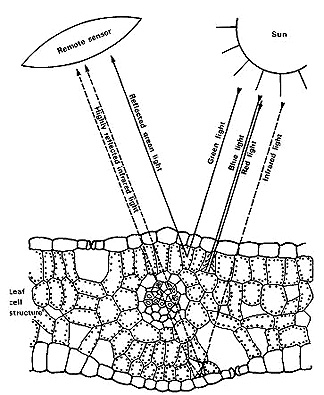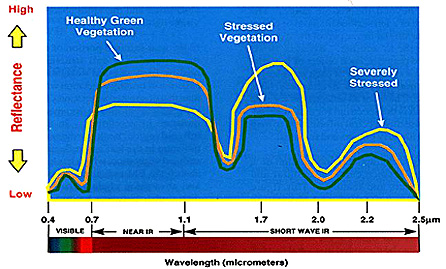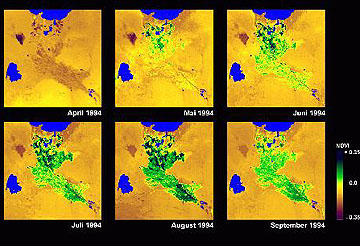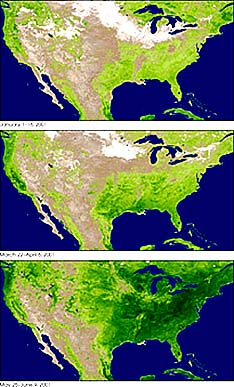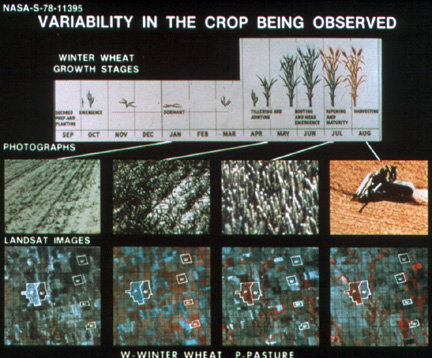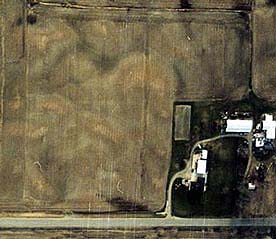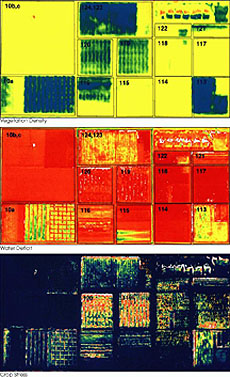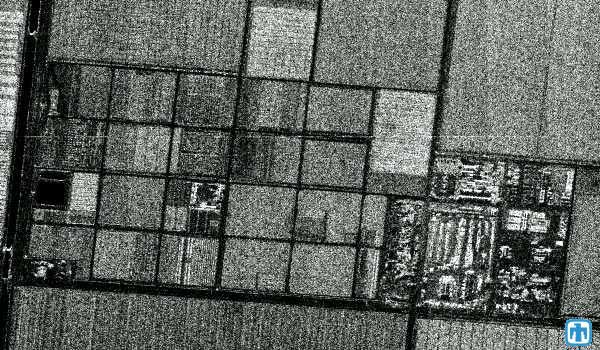VEGETATION APPLICATIONS:¶
Contents
Vegetation can be distinguished using remote sensing data from most other (mainly inorganic) materials by virtue of its notable absorption in the red and blue segments of the visible spectrum, its higher green reflectance and, especially, its very strong reflectance in the near-IR. Different types of vegetation show often distinctive variability from one another owing to such parameters as leaf shape and size, overall plant shape, water content, and associated background (e.g., soil types and spacing of the plants (density of vegetative cover within the scene). Even marine/lake vegetation can be detected. Use of remote sensing to monitor crops, in terms of their identity, stage of growth, predicted yields (productivity) and health is a major endeavor. This is an excellent example of the value of multitemporal observations, as several looks during the growing season allows better crop type determination and estimates of output. Vegetation distribution and characteristics in forests and grasslands also are readily determinable.
VEGETATION APPLICATIONS:¶
General Principles For Recognizing Vegetation¶
Because many remote sensing devices operate in the green, red, and near infrared regions of the electromagnetic spectrum, they can discriminate radiation absorption and reflectance of vegetation. One special characteristic of vegetation is that leaves, a common manifestation, are partly transparent allowing some of the radiation to pass through (often reaching the ground, which reflects its own signature). The general behavior of incoming and outgoing radiation that acts on a leaf is shown here:
Now, consider this diagram which traces the influence of green leafy material on incoming and reflected radiation.
Absorption centered at about 0.65 µm (visible red) by chlorophyll pigment in green-leaf chloroplasts that reside in the outer or Palisade leaf, and to a similar extent in the blue, removes these colors from white light, leaving the predominant but diminished reflectance for visible wavelengths concentrated in the green. Thus, most vegetation has a green-leafy color. There is also strong reflectance between 0.7 and 1.0 µm (near IR) in the spongy mesophyll cells located in the interior or back of a leaf, within which light reflects mainly at cell wall/air space interfaces, much of which emerges as strong reflection rays. The intensity of this reflectance is commonly greater (higher percentage) than from most inorganic materials, so vegetation appears bright in the near-IR wavelengths. These properties of vegetation account for their tonal signatures on multispectral images: darker tones in the blue and, especially red, bands, somewhat lighter in the green band, and notably light in the near-IR bands (maximum in Landsat’s Multispectral Scanner Bands 6 and 7 and Thematic Mapper Band 4 and SPOT’s Band 3).
Identifying vegetation in remote-sensing images depends on several plant characteristics. For instance, in general, deciduous leaves tend to be more reflective than evergreen needles. Thus, in infrared color composites, the red colors associated with those bands in the 0.7 - 1.1 µm interval are normally richer in hue and brighter from tree leaves than from pine needles.
One of the most successful applications of multispectral space imagery is monitoring the state of the world’s agricultural production. This application includes identifying and differentiating most of the major crop types: wheat, barley, millet, oats, corn, soybeans, rice, and others.
This capability was convincingly demonstrated by an early ERTS-1 classification of several crop types being grown in Holt County, Nebraska. This pair of image subsets, obtained just weeks after launch, indicates what crops were successfully differentiated; the lower image shows the improvement in distinguishing these types by using data from two different dates of image acquisition:
Perhaps this is a good point in the discussion to introduce the appearance of large area croplands as they appear in Landsat. We will illustrate with imagery that cover the two major crop growing areas of the United States.
The first is part of the Great or Central Valley of California, specifically the San Joaquin Valley. Agricultural here is primarily associated with such cash crops as barley, alfalfa, sugar beets, beans, tomatoes, cotton, grapes, and peach and walnut trees. In July of 1972 most of these fields are nearing full growth. Irrigation from the Sierra Nevada, whose foothills are in the upper right compensates for the sparsity or rain in summer months. The eastern Coast Ranges appear at the lower left. The yellow-brown and blue areas flanking the Valley crops are grasslands and chapparal best suited for cattle grazing. The blue areas within the croplands (near the top) are the cities of Stockton and Modesto.
The second Landsat image is in the Wheat Belt of the Great Plains. The image below is of western Kansas in late August. Most of the scene consists of small farms, many of section size (1 square mile). The principal crop is winter wheat which is normally harvested by June. Spring wheat is then planted, along with sorghum, barley, and alfalfa. This scene is transitional, with nearly all of the right side being heavily planted, but the left side (the High Plains, at higher elevations) contains some unplanted farms and barren land, some used for grazing.
Many factors combine to cause small to large differences in spectral signatures for the varieties of crops cultivated by man. Generally, we must determine the signature for each crop in a region from representative samples at specific times. However, some crop types have quite similar spectral responses at equivalent growth stages. The differences between crop (plant) types can be fairly small in the Near-Infrared, as shown in these (offset) spectral curves (in which other variables such as soil type, ground moisture, etc. are in effect held constant).
` <>`__3-1: Drawing on your experience and common sense, make (or think) a list of the factors that will affect the spectral signatures of field crops. `ANSWER <Sect3_answers.html#3-1>`__
Through remote sensing it is possible to quantify on a global scale the total acreage dedicated to these and other crops at any time. Of greater import, is accurately (best case 90%) estimating the expected yields (production in bushels or other units) of each crop, locally, regionally or globally. We do this by first computing the areas dedicated to each crop, and then incorporating reliable yield assessments per unit area, which agronomists can measure at representative ground-truth sites (or in the U.S., county farm agents obtain routinely from the farmers themselves). Reliability is enhanced by using the repeat coverage of the croplands afforded by the cyclical satellite orbits assuming, of course, cloud cover is sparse enough to foster several good looks during the growing season. Usually, the yield estimates obtained from satellite data are more comprehensive and earlier (often by weeks) than determined conventionally as harvesting approaches. Information about soil moisture content, often critical to good production, can be qualitatively (and under favorable conditions, quantitatively) appraised with certain satellite observations.
Under suitable circumstances, it is feasible to detect crop stress generally from moisture deficiency or disease and pests, and sometimes suggest treatment before the farmers become aware of problems. Stress is indicated by progressive decrease in Near-IR reflectance but a reversal in Short-Wave IR reflectance, as shown in this general diagram:
This effect is evidenced quantitatively in this set of field spectral measurements of leaves taken from soybean plants as these underwent increasing stress that causes loss of water and breakdown of cell walls.
Differences in vegetation vigor, resulting from variable stress, are especially evident when Near Infrared imagery or data are used. In this aerial photo made with Color IR film shows healthy vegetation in red, and “sick” (stressed) vegetation in blue to yellow-white:
For identifying crops, two important parameters we use are the size and shape of the crop type ( e.g. soybeans have spread out leaf clumps; corn has tall stalks with long, narrow leaves and thin, tassle-topped stems; and wheat [in the cereal grass family] has long thin central stems with a few small, bent leaves on short branches, all topped by a head containing the kernels from which flour is made). Other considerations are the surface area of individual leaves, the plant height and amount of shadow it casts, and the spacing or other planting geometries of row crops (the normal arrangement of legumes, feed crops, and fruit orchards). The stage of growth (degree of crop maturity) is also a factor. For example during its development wheat, passes through several distinct steps such as, developing its kernel-bearing head, and changing from shades of green to golden-brown (see below).
Another related parameter is Leaf Area Index (LAI), defined as the ratio of one-half the total area of leaves (the other half is the underside) in vegetation to the total surface area containing that vegetation. If all the leaves were removed from a tree canopy and laid on the ground, their combined areas relative to the ground area projected beneath the canopy would be some number greater than 1 but usually less than 10. As a tree, for example, fully leaves, it will produce some LAI value that is dependent on leaf size and shape, the number of limbs, and other factors. The LAI is related to the the total biomass (amount of vegetative matter [live and dead] per unit area, usually measured in units of tons or kilograms per hectare [2.47 acres]) in the plant and to various measures of Vegetation Index (see below). Estimates of biomass can be carried out with variable reliability using remote sensing inputs, provided there is good supporting field data and the quantitative (mathematical) models are efficient. Both LAI and NDVI (page 3-4) are used in the calculations.
In principal, actual LAI must be determined on site directly by stripping off all leaves, but in practice it can be estimated by statistical sampling or by measuring some property such as reflectance. Thus, remote sensing can determine an LAI estimate if the reflectances are matched with appropriate field or ground truth. For remotely sensed crops, LAI is influenced by the amount of reflecting soil between plant (thus looking straight down will see both corn and soil but at maturity a cornfield seems closely spaced when viewed from the side). For the spectral signatures shown below, the Near IR reflectances will increase with LAI.
This change in appearance and extent of surface area coverage over time is the hallmark of vegetation as compared with most other categories of ground features (especially those not weather-related). Crops in particular show strong changes in the course of a growing season, as illustrated here for these three stages - bare soil in field; full growth; fall senescence:
` <>`__3-2: How would non-growing or dead vegetation (such as crops in senescence) be detected by Landsat? `ANSWER <Sect3_answers.html#3-2>`__
The study of vegetation dynamics in terms of climatically-driven changes that take place over a growing season is called phenology. A good example of how repetitive satellite observations can provide updated information on the phenological history of natural vegetation and crops during a single cycle of Spring-Summer growth is this sequence of AVHRR images of the Amu-Dar’ja Delta just south of the Aral Sea in Ujbekistan (south-central Asia).The amount of vegetation present in the delta (a major farming district for this region) is expressed as the NDVI, an index defined on page 3-4. The Aral Sea - a large inland lake - is now rapidly drying up (see page page 14-15).
More generally, seasonal change appears each year with the “greening” that comes with the advent of Spring into Summer as both trees and grasses commence their annual growth. The leafing of trees in particular results in whole regions becoming dominated by active vegetation that is evident when rendered in a multispectral image in green tones. The MODIS sensor on Terra has several vegetation-sensitive bands used to calculate a variation of the NDVI called the Enhanced Vegetation Index (EVI). This trio of images (dates in the caption) shows the spread of growing natural vegetation across the U.S.
To emphasize the variability of the spectral response of crops over time, we show these phenological stages for wheat in this sequential illustration:
Note that, in the Landsat imagery, the wheat fields (particularly the light-blue polygon in the far-left image) show their brightest response in the IR (hence red) during the emergent stage but become less responsive by the ripening stage. The grasses and alfalfa that make up pasture crops mature (redden) much later.
` <>`__3-3: The display above was made as part of the LACIE program, designed to demonstrate that crop history can be monitored by satellite and that productivity (yield in bushels) and prediction of total yield in a season from regions of major productions can be quantitatively assessed. How were the specific crop types used as training sites identified (determined)? `ANSWER <Sect3_answers.html#3-3>`__
With this survey of the role of several variables in determining crop types, let us look now at one of the most successful classifications reported to date. These are being achieved by hyperspectral sensors such as AVIRIS (page 13-9) and Hyperiorn. The Hyperion hyperspectral sensor on NASA’s EO-1 ((Page Intro-24) has procured multichannel data for Coleambally test area in Australia. This image, made from 3 narrow channels in the visible-Near IR, shows how the fields of corn, rice, and soybeans changed their reflectances during the (southern hemisphere) growing season: . Notice the pronounced differences in crop shapes which is a big factor in producing the reflectance differences (healthy leaf vegetation generally has a signature that does not vary much in percent reflectance, so that differences in crop shape become the distinguishing factor).
The multichannel data from Hyperion were used to plot the observed spectral signatures for the soil and three crops, as shown here (the curves identified in the upper right [the writing is too small to be decipherable on most screens] are, from top to bottom, soil, corn, rice, and soybeans):
|Spectral signatures of four ground classes derived from data monitored by the Hyperion sensor on EO-1; |
Using a large number of selected individual Hyperion channels, this supervised classification of the four classes in the subscene was generated; this end result is more accurate than is normally achievable with broad band data such as obtained by Landsat:
|Classification of corn, rice, soybeans, and bare soil in Australian fields, using EO-1 Hyperion data. |
An additional image variable is the crop’s background, namely the nurturing soil, with color and other properties changing with the particular soil type, and reflectance depending on the amount of moisture it holds. Moisture tends to darken a +given soil color, readily picked up in aircraft imagery as seen in this pair of images:
Often, the distribution of moisture, as soil dries differentially, is variable in an imaged barren field giving rise to a mottled or blotchy appearance. Thermal imagery (Section 9) brings out the differential soil moisture content by virtue of temperature variations. The amount of water in the crop itself also affects the sensed temperature (stressed [water deficient] or diseased crop material is generally warmer). Soil water variations are evident in this image made by an airborne thermal sensor of several fields, where high moisture correlates with blue and drier parts of the fields with reds and yellows:
A combination of visible, NIR, and thermal bands can pick up both water deficiency and the resulting stress on the crops in the fields. This set of three images was made by a Daedulus instrument flown on an aircraft. In the top image, yellow marks unplanted fields and those in blue and green are growing crops. The center image picks up patterns of water distribution in the crop fields. The bottom image shows levels of stress related in part to insufficient moisture.
Passive microwave (page 8-8) also picks up soil moisture. Cooler areas appear dark in images of fields overflown by a microwave sensor - although other factors, such as absence or presence of growing crops (and their types) besides moisture can account for some darker tones:
|Passive microwave image obtained during an overflight of |
Radar likewise can detect variations in soil moisture in agricultural fields. Below is a C-band airborne SAR image of an experimental station at Maricopa, AZ near Phoenix. The darker fields are those with both higher moisture and growing crops which, in this case, produce less returns to the SAR receiver.
Active microwave sensors, or radar, can use several variables to recognize crop vegetation and even develop a classification of crop types. Here is a SIR-C (Space Shuttle) image of farmland in the Netherlands, taken on April 4, 1994. The false color composite was made with L-band in the HH polarization mode = red; L-band HV = green; and C-band HH = blue (see page 8-5).

